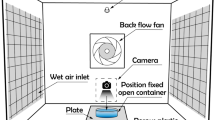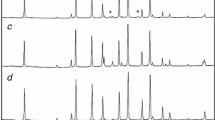Abstract
A mathematical model of multicomponent vacuum desorption, which occurs in the vacuum freeze drying process has been developed. Drying with conductive heating and constant contact surface temperature was considered. Pressure drop in the layer of the material to be dried was taken into account in the model formulation and process simulation. Equilibrium moisture content for pure water, toluene, and m-xylene and their two- and three-component mixtures on zeolite DAY 20F were described by means of the multitemperature extended Langmuir isotherm equation. Model equations were solved by the numerical method of lines. Moisture content and temperature distributions within the drying material were predicted from the model as a function of drying time.
Similar content being viewed by others
Abbreviations
- a e :
-
Effective thermal diffusivity, m2/s.
- a i :
-
Constant of multitemperature Langmuir isotherm of component i, K.
- b i :
-
Constant of multitemperature Langmuir isotherm of component i, Pa−1.
- c a i :
-
Specific heat of component i in adsorbed phase, J/(kg K).
- c pg i :
-
Specific heat of component i in gas (vapor) phase, J/(mol K).
- c i :
-
Constant of multitemperature Langmuir isotherm of component i, K.
- c s :
-
Specific heat of adsorbent, J/(kg K).
- C :
-
Molar gas density, mol/m3.
- C i0 :
-
Initial molar concentration of component i in the gaseous phase, mol/m3.
- C * i :
-
Dimensionless molar concentration of component i in the gas phase.
- d p :
-
Particle diameter, m.
- D eff i :
-
Effective diffusion coefficient of component i, m2/s.
- D K i :
-
Knudsen diffusion coefficient of component i, m2/s.
- D S i :
-
Surface diffusion coefficient of component i, m2/s.
- ΔH i :
-
Heat of adsorption of component i, J/mol.
- J z :
-
Mass flux density, mol/(m2 s).
- k e :
-
Effective thermal conductivity of adsorbent bed, W/(mK).
- k D :
-
Permeability of porous media (m2).
- k E :
-
Parameter describing the inertial effect in Ergun’s equation (m).
- K i :
-
Kinetic coefficient of component i, 1/s.
- L :
-
Dried layer thickness, m.
- M i :
-
Molecular weight of component i, kg/mol.
- N :
-
Number of sections of drying material layer.
- p i :
-
Partial pressure of component i, Pa.
- ΔP :
-
Reference pressure variation for normalization, Pa.
- P :
-
Total pressure, Pa.
- X avg i :
-
Average moisture content of component i (dry basis), kg i/kg.
- X i :
-
Moisture content of component i (dry basis), kg i/kg.
- X * i :
-
Equilibrium moisture content of component i (dry basis), kg i/kg.
- y i :
-
Mole fraction of component i in the gas phase, mol i/mol.
- t :
-
Time, s.
- ΔT :
-
Reference temperature variation for normalization, K.
- T :
-
Temperature, K.
- T i :
-
Initial temperature of drying layer, K.
- T0 :
-
Contact surface temperature, K.
- y i :
-
Mole fraction of component i, mol i/mol.
- z :
-
Axial coordinate, m.
- Z :
-
Dimensionless axial coordinate.
- Greek symbols :
-
- ε:
-
Bed void fraction.
- ε p :
-
Particle porosity.
- μ:
-
Viscosity of gas mixture, Pa s.
- ω:
-
Normalized pressure.
- θ:
-
Normalized temperature.
- Ω i :
-
Dimensionless concentration of component i in solid phase.
- ρ p :
-
Particle density of adsorbent, kg/m3.
- ρ b :
-
Bulk density of adsorbent, kg/m3.
- τ:
-
Dimensionless time.
- Acronyms :
-
- VC:
-
Vacuum chamber.
- LDF:
-
Linear driving force.
References
Borger T., Salden A., Eigenberger G. (1997) A combined vacuum and temperature swing adsorption process for recovery of amine from foundry air. Chem. Eng. Proc. 36, 231–244
Brihi T.A., Jaubert J.-N., Barth D. (2002) Determining volatile organic compounds’ adsorption isotherms on dealuminated Y zeolite and correlation with different models. J. Chem. Eng. Data 47, 1553–1557
Chahbani M.H., Tondeur V. (2001) Pressure drop in fixed-bed adsorbers. Chem. Eng. J. 81, 23–34
Do D.D. (1998) Adsorption Analysis: Equilibria and Kinetics. Imperial College Press, London
Ergun S. (1952) Fluid flow through packed column. Chem. Eng. Prog. 48, 89–94
Glueckauf E. (1955) Theory of chromatography. Trans. Faraday Soc. 51, 1540–1551
Goldblith S.A., Rey L., Rothmayr W.W. (1975) Freeze-drying and Advanced Food Technology. Academic Press, London
Hall K.R., Eagleton L.C., Acrivos A., Vermeulen T. (1966) Pore- and Solid-Diffusion Kinetics in Fixed bed Adsorption under Constant-Pattern Conditions. Academic Press, London
Hill T.L. (1949) Statistical mechanics of adsorption. V. thermodynamics and heat of adsorption. J. Chem. Phys. 17, 520–535
Kim M.-B., Ryu Y.-K., Lee C.-H. (2005) Adsorption equilibria of water vapor on activated carbon and DAY zeolite. J. Chem. Eng. Data 50, 951–955
Laurent S., Couture F., Roques M. (1999) Vacuum drying of a multicomponent pharmaceutical product having different pseudo-polymorphic forms. Chem. Eng. Proc. 38, 157–165
Liapis A.I., Bruttini R. (1995) Freeze-drying of pharmaceutical crystalline and amorphous solutes in vials: Dynamic multi-dimensional models of the primary and secondary drying stages and qualitative features of the moving interface. Dry. Technol. 13, 43–72
Liapis A.I., Pikal M.J., Bruttini R. (1996) Research and developments needs and opportunities in freeze drying. Dry. Technol. 14, 1265–1300
Nastaj J., Ambrożek B. (2005) Modeling of vacuum desorption in freeze drying process. Dry. Technol. 23, 1693–1709
Poling B.E., Prausnitz J.M., O’Connell J.P. (2000) The Properties of Gases and Liquids – 5th ed. McGraw-Hill, New York
Rowe T.W., Snowman J.W. (1978) Edwards Freeze-Drying Handbook. Crawley, Cambridge
Ruthven D.M. (1984) Principles of Adsorption and Adsorption Processes. Wiley Interscience, New York
Ryu Y.-K., Chang J.-W., Jung S.-Y., Lee C.-H. (2002) Adsorption isotherms of toluene and gasoline vapors on DAY zeolite. J. Chem. Eng. Data 47, 363–366
Sadikoglu H., Lapis A.I. (1997) Mathematical modeling of the primary and secondary drying stages of bulk solution freeze-drying in trays: parameter estimation and model discrimination by comparison of theoretical results with experimental data. Dry. Technol. 15, 791–810
Schiesser W.E. (1991) The Numerical Method of Lines: Integration of Partial Differential Equations. Academic Press, New York
Sun L.M., Ben Amar N., Meunier F. (1995) Numerical study on coupled heat and mass transfer in an adsorber with external fluid heating. Heat Recovery Systems & CHP 15, 19–29
Wolf H.E., Schlünder E.U. (1999) Adsorption equilibrium of solvent mixtures on silica gel and silica gel coated ceramics. Chem. Eng. Process 38, 211–218
Yao C. (2000) Extended and improved Langmuir equation for correlating adsorption equilibrium data. Sep. Purif. Technol. 19, 237–242
Author information
Authors and Affiliations
Corresponding author
Rights and permissions
About this article
Cite this article
Nastaj, J.F., Ambrożek, B. Modeling of vacuum desorption of multicomponent moisture in freeze drying. Transp Porous Med 66, 201–218 (2007). https://doi.org/10.1007/s11242-006-9015-1
Received:
Accepted:
Published:
Issue Date:
DOI: https://doi.org/10.1007/s11242-006-9015-1




